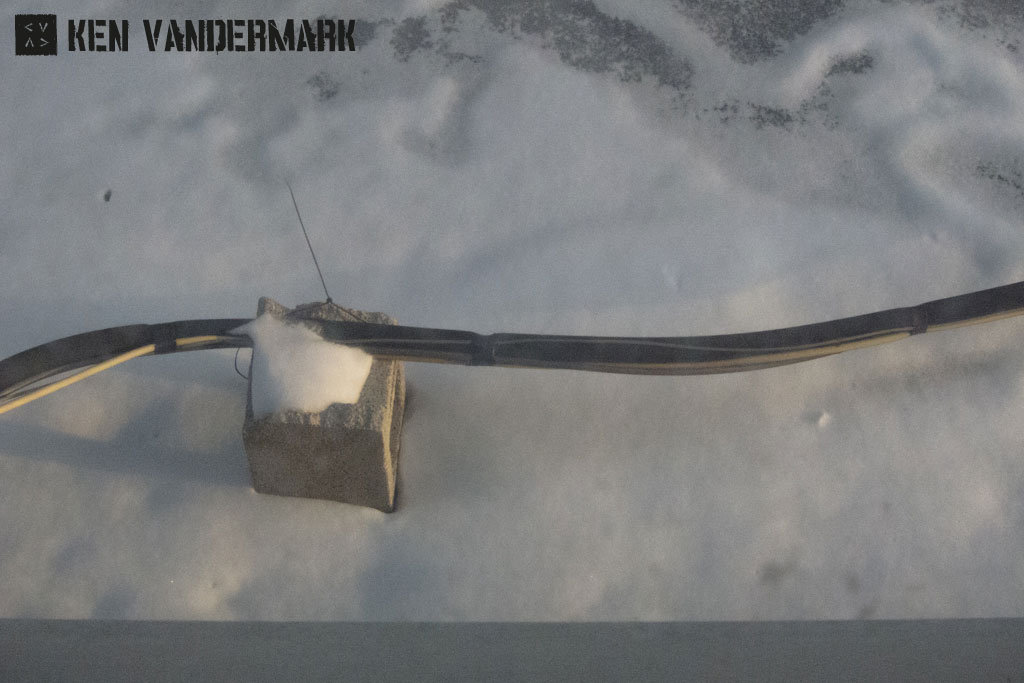

This is the 3rd collaboration between the visual artist, Richard Hull, and myself. The 1st took place at the Chicago Arts Club in the autumn of 2001; the 2nd took place at the Carrie Secrest Gallery over 4 concerts between the fall of 2005 and summer of 2006. In all 3 cases, Richard and I have been very aware of the issues present when combining visual work and improvised music, particularly the cliches associated with mixing “action painting” and “free jazz” in a performance. The fact that a painting usually takes many, many hours to create while a concert of improvised music takes place in real time, coupled with the fact that the visual aspects of experience tend to take precedence over what people apprehend through sound, make integrating visual art and music into a single experience, where both elements carry equal creative weight, a real challenge. The piece, (re)Compose, is the most recent solution Richard and I have found to address this problem.
In the liner notes to his solo album, “Fixations,” the internationally renowned improviser, John Butcher, states, “For a while I came under the spell of John Cage and, whilst there’s undoubtedly something refreshing about ‘allowing sounds to be themselves,’ it soon became clear that for improvisation to make sense, sounds must be put to work.” The music written for (re)Compose is unique in my work, an attempt to “put sounds to work” by utilizing materials inspired by the compositional ideas of the New York School: John Cage, Morton Feldman, Christian Wolff, and Earl Brown. As is typical during my creative process, the source of inspiration quickly transformed into another state during the activity of composing. The “gamut” ideas of early Cage pieces became coupled with Feldman’s first method of not designating specific pitch or duration in his musical notation; Wolff’s manipulation of only 4 to 5 pitches in his initial work evolved into a tone row of 12 pitches covering the chromatic scale; only Brown’s idea regarding “open form” remained somewhat consistent with his interest in allowing performers to choose the sequence of material during a concert, permitting the music to be experienced in spontaneous ways while remaining specific to elements written for a particular composition. Also related to Cage’s work is the use of chronological durations to designate the overall structure of the (re)Compose. These methodologies are all atypical for my general compositional work, but taking advantage of this collaboration to explore different musical procedures seemed appropriate, as was the use of durations to shape the piece because it gave Richard and I a “map” with which to navigate a mutual set of space- one visual, one aural.
When putting the ensemble together I tried to combine improvising musicians I was very familiar with, and players I didn’t know very well. Initially the “known” (Jeb Bishop [trombone] and Tim Daisy [percussion]), coupled with the “unknown” (James Falzone [clarinet], Lou Mallozzi [turntables, CDs, microphones, mixer], and Tomeka Reid [cello]). [To say “unknown” here is to express my lack of experience with these musicians’ work- all three are quite well known and respected as creative musicians and improvisers.] Due to unfortunate circumstances, Jeb Bishop was unable to participate. I asked the bassist, Jason Roebke, to be a part of the ensemble (another musician who I am less familiar with). Luckily, he was available and wanted to take part in the project. So, for me, the compositional and performance aspects of this collaboration with Richard has led me into a lot of new territory, which I hope will continue to inform my upcoming music in original ways. I want to thank all of the artists involved for taking part in this experiment, both during the work in rehearsal, and now in performance.
The visual/musical interaction of (re)Compose is analogous to the indeterminate relationships found in the collaboration between composer John Cage and choreographer Merce Cunningham; neither component helps define or illustrate the other, and hopefully both are complete in and of themselves but in a way that makes the sum greater than the parts.
-Ken Vandermark
Examples of Richard Hull’s work: http://www.westernexhibitions.com/hull/index.htm
© 2024 Ken Vandermark – musician & composer | Disclaimer